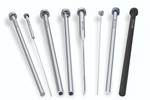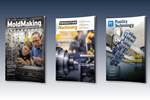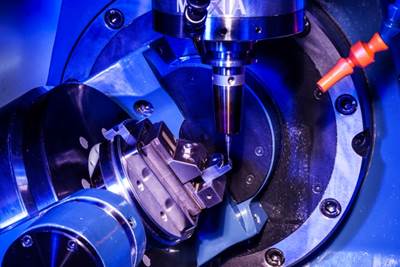
A mold produced on a desktop resin 3D printer. Source (All images) | APSX
As moldmakers face increasing pressures to deliver faster and more cost-effective solutions, integrating 3D printing (3DP), machining and desktop injection molding into the process can offer significant advantages for both novice and advanced moldmakers.
Desktop Molding
Desktop injection molding machines can provide a gateway into industrial-grade molding without the complexity or high cost of traditional large-scale machines. A compact, user-friendly design enables quick setup and operation, making the machines a good option for moldmakers looking to cross-train or train the next generation of workers.
“By enabling hands-on experience with real-world materials, these machines make it easy for novices to understand injection molding fundamentals, such as material behavior, cooling times and pressure parameters, without the steep learning curve typically associated with larger systems,” says Kubi Kara, President of APSX LLC.
Desktop injection molding machines can handle a wide range of materials,
including but not limited to polypropylene (PP), glass-filled polypropylene, FDA-approved plastics, polyethylene (PE), thermoplastic polyolefin (TPO), nylon, polycarbonate (PC), acetal (Delrin), ABS and PC/ABS.
An automatic desktop plastic injection molding machine can make injection molding affordable and easy, including this heavy-duty machine for continuous or single-cycle plastic part production.
“These materials should have a Melt Flow Rate (MFR) of 3 g/10 minute or higher (ASTM D1238) for optimal performance,” says Kara. The machine typically uses standard size (approximately 0.125" diameter) virgin plastic pellets. Some customers also use recycled plastic material. Plus, it’s possible to process metal injection molding (MIM) feedstock pellets with these machines.
While desktop machines operate at slower speeds compared to traditional industrial machines (with typical cycle times around 60 seconds), they offer impressive capabilities. For example, one mini automatic plastic injection molding machine provides 5000 PSI injection pressure and 5 tons of clamp force.
“Due to its unique design, it can produce large parts comparable to those made by 30-plus-ton industrial machines. The maximum shot size is 30 cu-cm (1.83 cu-in), which can be used to produce palm-sized parts,” says Kara.

A highly precise, rigid, portable desktop CNC milling machine machines a mold. This machine can mill aluminum, steel, bronze, brass, delrin wood and plastics with high precision.
Desktop Swiss
Advanced users can leverage desktop Swiss lathes for high-precision tasks like creating custom ejector pins and inserts. These components are crucial for fine-tuning part ejection and improving overall mold quality, yet they often require tedious manual machining. A desktop Swiss lathe can eliminate this bottleneck by producing these components with precision, reducing both lead times and labor costs.
“The precision and surface finish of mold components produced by a desktop Swiss lathe can be comparable to those created through existing processes. For example, a compact CNC Swiss lathe can achieve high-quality surface finishes through careful programming with high-level details. While this process may be slower, the results can be excellent. Machining can be programmed at a faster pace in cases where finish is less critical, says Kara”.
In combination with a desktop CNC machine, which is capable of machining aluminum molds for prototype and small-batch production, this setup can help experienced moldmakers to accelerate the entire moldmaking process. The ability to quickly iterate on mold designs using 3D printing, followed by precision machining and injection molding, offers an end-to-end solution that can significantly enhance workflow efficiency.

A mold plate and ejector pins made with a desktop Swiss CNC machine.

An aluminum mold made with ejector pins using a desktop Swiss CNC machine.
3D Printing
To optimize the integration of 3D printing into moldmaking, Kara says, “SLA (stereolithography) technology is preferred over FDM (fused deposition modeling) due to its superior surface finish and precision. SLA parts are chemically bonded, dense and isotropic, making them suitable for detailed mold creation, including surface textures directly from the printer.”
When selecting materials, it's essential to choose ones that can withstand the clamping force, injection pressure and high temperatures typical in molding.
“Some recommended options include Formlabs Rigid 10K or High Temp, Asiga FusionGray, Markforged Onyx, and Nexa3D xMold or xCeramic. You can achieve 500 plus cycles by using these 3D printed molds. For optimal results, print at 50-micron layers and ensure proper post-processing, which may involve CNC machining or hand sanding after post-curing to refine the mold surface,” says Kara.
“In combination with a desktop CNC machine, which is capable of machining aluminum molds for prototype and small-batch production, this setup can help experienced moldmakers accelerate the entire moldmaking process.”
Scalability and Cost-Effectiveness
By adopting these desktop technologies, moldmakers can create high-quality molds while minimizing the need for outsourcing or expensive machinery. These electric, automated systems not only streamline production but can also provide the flexibility to handle various custom part applications. When considering scalability for larger production runs, Kara suggests two main options:
- Add more desktop units as demand grows until space constraints are reached.
- Use desktop units to test the market, then transition directly to industrial-size machines if there's sufficient demand.
The transition point from desktop to traditional large-scale injection molding machines depends on various factors, including space constraints and market demand.
“The initial investment difference between desktop units and industrial machines can be substantial, so the transition should be carefully planned, considering all aspects of operation, including learning curves, continuous maintenance and potential spare part needs,” says Kara.

A precise, rigid desktop CNC Swiss lathe can machine metals and plastics.
Learning Curve and Training
The learning curve for experienced staff to become proficient with the 3D printing and desktop CNC machining aspects of this integrated manufacturing approach is relatively quick for those with relevant technical backgrounds.
“Basic proficiency can typically be achieved within a few weeks of hands-on experience, while mastering more advanced functions may take several months of practice,” says Kara.
Specialized training programs, including workshops, certifications and manufacturer-specific training programs, are available to expedite the learning process. These cover everything from machine operation to material selection and advanced techniques, supporting both cross-training of employees and the education of the next generation of moldmakers.
Making the Move
Whether you're a novice learning the ropes or a seasoned moldmaker looking to optimize your operations, desktop machines may offer a versatile, scalable option to meet the demands of today's fast-paced manufacturing environment. Embracing these tools also supports the cross-training of employees and the training of the next generation, ensuring that the skills required for high-quality moldmaking are accessible and attainable for all levels of expertise.
“While a detailed cost-benefit analysis comparing this integrated desktop system to current moldmaking processes would require further study, particularly regarding industrial machinery operating costs, the potential benefits in terms of flexibility, training opportunities and rapid prototyping capabilities make this an attractive option for many moldmakers looking to stay competitive in an evolving industry. These desktop systems are not new. Many reputable organizations, including the NAVY, ARMY, NASA and several global companies, have been using them since 2017 for various purposes,” says Kara.
Related Content
Revisiting Some Hot Runner Fundamentals
What exactly does a hot runner do? If you’ve been in the injection molding industry for any length of time, you might think the answer is obvious, but it is not.
Read MoreMachining Center Spindles: What You Need to Know
Why and how to research spindle technology before purchasing a machining center.
Read MoreIt Starts With the Part: A Plastic Part Checklist Ensures Good Mold Design
All successful mold build projects start with examining the part to be molded to ensure it is moldable and will meet the customers' production objectives.
Read MoreThe Benefits of Hand Scraping
Accuracy and flatness are two benefits of hand scraping that help improve machine loop stiffness, workpiece surface finish and component geometry.
Read MoreRead Next
Ejector Pin Selection Guide
A review of materials, treatments and coatings to help determine the proper pins for optimized plastic part ejection.
Read MoreGrowth Requires Mold Builder/Molder to Shift Tooling Focus to Maintenance, Repair and Replacement
The results of aligning awareness and acceptance across departments to balance new tooling and quick response needs.
Read MoreTriple Threat: How One Shop's Success Resonates Across Three End Markets
When I revisited Eden Tool in New Freedom, PA, this past summer for a follow-up feature on this mold builder’s growth, I underestimated the story.
Read More
























